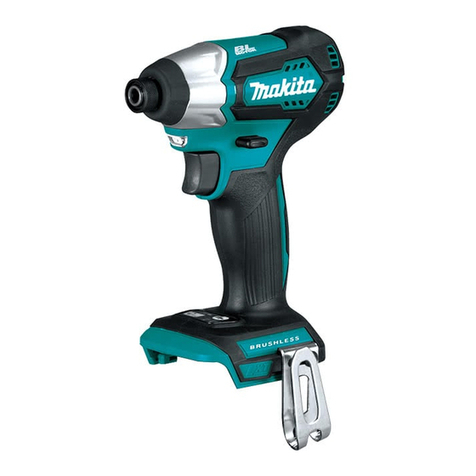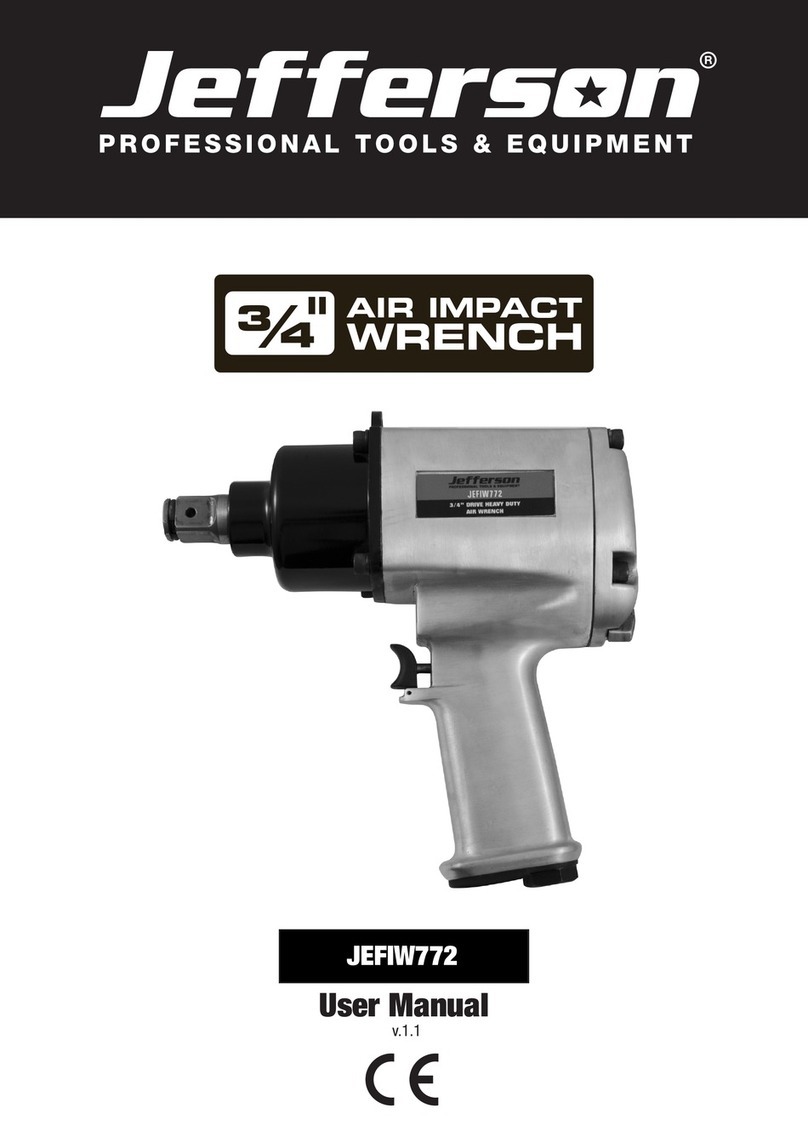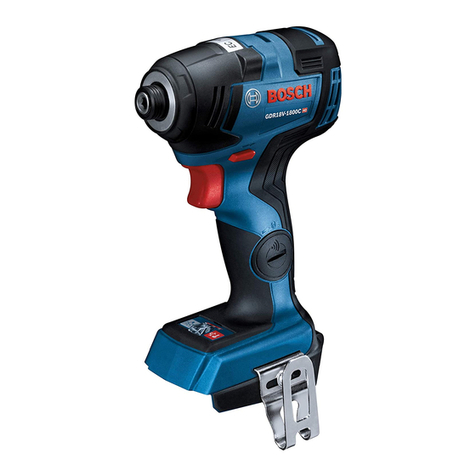FESTA 28003 Instruction manual

1
Manual for use
Item number: 28003, 28004
Please read this manual carefully before using.

2

3
Technical specifications
Item
Cordless drill
Speed without load
I.0-500min-1 II.0-1800min-1
Number of percussions
0-19200min-1
Torque (soft/hard)
45Nm
Max. battery voltage
20V
Number of torque levels
19+1+1+1
Chuck head clamping range
2-13mm
Weight with battery 2000 mAh
1,7kg
Protection marking
IPX0
Sound pressure level, uncertainty K
LpA= 79dB(A), K= 5dB(A)
Sound power level, uncertainty K
LwA= 90dB(A), K= 5dB(A)
Max total vibration for drilling without
percussion into metal ah.D
ah.D= 2,4m/s2; K= 1,5m/s2
Max to tal vibration for drilling with percussion
into concrete ah.ID
ah.ID= 7,5m/s2; K= 1,5m/s2
Components and controls
1) Trigger
2) Keyless chuck head
3) Torque setting ring
4) Operating mode setting ring
5) Speed level toggle switch
6) Rotation direction toggle switch
7) Handle
8) Hanging hook
9) Battery
10) Battery release button
11) LED indicator light for illuminating work area

4
Manual for battery treatment
•Depending on the characteristics of the lithium battery, it is important to check the charge
level after 3 months. If the charge level is low, you need to ensure the battery charge.
•If you leave the battery pack for a long time without charging, the charge level may drop to
a very low level or the battery pack may discharge completely. In this case the battery may
be damaged.
•After the battery pack is fully charged, it can be left unused for a long time. It is generally
recommended to check the battery at least every 3 months.
•When using the cordless tools with batteries, please remember to charge the battery in time
after use. Otherwise, the battery will be easy damaged.
Charging the battery
APPROXIMATE CHARGE TIMES WITH CHARGERS
4000 mAh
4 A quick charger (28086)
55 min.
2,4 A quick charger (28085)
90 min.
2000 mAh
4 A quick charger (28086)
30 min.
2,4 A quick charger (28085)
40 min.
WARNING
Before preparing and using the cordless tool for use, read the entire instruction manual and keep
it with the product so that the operator can familiarize himself with it.
If you lend or sell the product to anyone, enclose this instruction manual with it. Avoid damaging
this manual. The manufacturer is not liable for damages or injuries caused by using the device,
which is in conflict with these instructions. Before using the appliance, familiarize yourself with all
its controls and components, as well as how to switch off the appliance, so that you can switch it
off immediately in the event of a dangerous situation. Before use, check that all components are
securely fastened and that any part of the device, such as the safety guards, is not damaged,
incorrectly installed or missing in place. This also applies to the charger and its power cord. If the
cordless tool, battery or charger is damaged or incomplete, do not use it and have it repaired or
replaced with original parts.
To check the battery charge level, press the button on the battery and, if necessary, charge the
battery according to the number of LEDs and the expected operating time of the cordless tool.
When the battery is fully charged, all LEDs are lit. The battery can be charged from any charge
level without reducing its capacity.
1. Insert the battery into the slots of the supplied charger first.
2. Before connecting the charger to a power source. current, check that the voltage in
the socket corresponds to the range 220-240 ~ 50 Hz and that the charger does not
have a damaged power cable (eg insulation) or cover or other part.
If the charger is damaged, have it replaced by a faultless original one from the manufacturer. Only
the original charger provided by the manufacturer must be used to charge the battery, otherwise

5
the use of another charger may cause a fire or explosion due to unsuitable charging parameters.
Protect the charger's power cord from damage.
3. Connect the charger to a wall outlet. current.
For 28085/28086 chargers
•when in charging process, it is indicated by a green flashing LED next to the red LED.
•when full charging, it is indicated only by a green LED on.
•when in abnormal charging process, it is indicated by both green and red flashing LED.
•The charge level of the battery can be monitored by the number of lit LEDs on the battery
that light up when the battery is being charged. We reserve the right to change the above
signaling of the charging and recharging process.
4. After charging, first disconnect the charger from the power source. power, and then
slide the battery out of the charger slots by pressing and holding the button on the
battery.
Description of battery functions
Display of remaining battery capacity
Attaching or removing the battery

6
Use
•Always use tools in perfect condition for cordless tools.
•If there is abnormal sound, vibration or operation while the unit is running, turn off the unit
immediately, remove the battery, and determine the cause of the abnormal operation. If the
abnormal operation is caused by a fault inside the device, have it repaired by an authorized
service center through a dealer or contact an authorized service center directly.
•When using the grinder, follow the safety instructions for the respective cordless tool.
Always use the cordless drill model 28000/28001/28002 with the front handle installed (not
supplied with other models).
1. Insert the battery into the slots in the handle of the cordless drill so that is clicks to the
place.
2. Set the required operating mode with the rotary knob for setting the operating mode
(position 4) (does not apply to 28008).
•For drilling mode in concrete, masonry, etc., set the working mode of hammer drilling
(hammer symbol on the ring).
•Set the screwdriving operating mode (screw symbol on the ring) for screwdriving /
tightening / loosening mode.
•For drilling in wood, plastic and similar materials, set the drilling mode (drill symbol) on the
ring.
•To set the desired operating mode, turn the ring so that the symbol of the corresponding
operating mode is in the position of the arrow on the drill body.
SPEED SETTING FOR OPERATING MODE
•Use the speed switch (position 5) to set the speed according to the type of work being
performed.
•Set the lower speed for screwdriving / tightening / loosening mode with the switch (higher
speed has a higher work force). When setting a lower speed, the number "1" is visible on
the switch.
•Set a higher speed for the switch drilling mode. When setting a higher speed, the number
"2" is visible on the switch.
WARNING
•Do not adjust the gear and torque while the drill is running.
CHANGING THE DIRECTION OF SPINDLE ROTATION
•Change the direction of rotation with the position switch 6.
SETTING A SUITABLE TORQUE
•In order to avoid tearing off the tip edges and notches of the tip head or damage to the
material due to too high a torque to which the connecting element is screwed, eg when
screwing thin screws into soft materials, it is suitable to turn the ring (position 3) to adjust

7
the torque torque set a gradually higher torque in the range 1-X according to the model of
the cordless drill. To set the torque,the numerical value must be placed in front of the arrow
on the drill body. As soon as the set torque is reached, the tip stops rotating and the spindle
starts to "jump" inside the drill cord with an audible regular "tr-tr-tr" sound. If the screw is
not screwed in or loosened sufficiently with the selected set torque, it is necessary to
increase the torque by the required degree. The optimal setting of the torque is suitable to
perform a practical test on a sample of screwed material using the same material and
screw.
INSERTING / REPLACING THE TOOL
•By holding the chuck head in your hand and turning the spindle to the left by pressing
the operating switch (position 1), the chuck will open to insert the tool shank. Insert the
tool shank deep enough into the chuck to secure the tool for work. Then secure the tool
by clamping the chuck by turning the spindle in the opposite direction. Thanks to the
"spin lock" function, the spindle rotation is automatically blocked when the chuck head
is held by hand, so that the tool can be easily changed by hand. The spindle is
automatically unlocked when the drill is started.
•Use a drill bit designed for the drill bit to drill. Use a wood drill for drilling in wood and a
metal drill for drilling in metal.
USING A BATTERY DRILL
•Press the operating switch and set the appropriate speed at the required direction of
rotation by pressing the operation switch. For loosening, it may be necessary to apply
adequate pressure to the cordless drill and start at low speed and at a suitably set torque
(see above) to preventthe bit from popping out of the screw pattern or tearing off the edges.
After sufficient unscrewing, the operating switch can be pressed more for higher speeds.
DRILLING
•Drill at higher speeds using a dedicated drill bit.
Safety instructions
1. Safety instructions for all work activities
•Hearing protection must be worn when hammer drilling. Exposure to noise can cause
hearing loss.
•An additional handle must be used. Loss of control can cause personal injury. Note: The
above warning only applies to tools supplied with an auxiliary handle.
•When performing an operation where the cutting tool may touch a hidden guide or its own
supply, hold the power tool by the gripping insulated surfaces. Contact of the tool with a
"live" wire can cause the non-insulatedmetal parts of the electromechanical tool to become
alive and can lead to electric shock to the user.
2. Safety instructions when using long drills
•Never use the machine at speeds higher than the maximum rated drill speed.
•At higher speeds, the drill is likely to bend if it is allowed to rotate freely without being in
contact with the workpiece, which can result in personal injury.

8
•Always start at low speed at the beginning of drilling and the tip of the drill must touch the
workpiece.
•It is only necessary to push in a straight line with the drill and must not be subjected to
excessive pressure. The drills can bend and crack or cause loss of control,which can result
in personal injury.
•In the case of applications where a considerable amount of dust is generated, such as
hammer drilling, cutting into masonry,drilling with a diamond drill, use an industrial vacuum
cleaner to remove dust.
•Do not use a cleaning vacuum cleaner to remove dust. Inhalation of dust is harmful to
health. Ensure adequate ventilation when working.
•When working, use certified eye, ear and respiratory protection with a sufficient level of
protection. Consult your personal protective equipment store for a sufficient level of
protection.
General safety instructions for power tools
CAUTION!
All safety instructions, operating instructions, pictures and regulations supplied with this
tool must be read. Failure to follow all of the following instructions may result in electric shock,
fire, and / or serious personal injury.
All instructions and instructions for use must be kept for future reference.
The term "power tool" in all of the following warnings refers to a mains-operated (flexible power
supply) or a battery-powered power tool (without a movable power supply).
1. SAFETY OF THE WORK ENVIRONMENT
a) Workplaces must be kept clean and well lit. Clutter and dark spaces are often the cause
of accidents.
b) Power tools must not be used in potentially explosive atmospheres where flammable
liquids, gases or dust are present. Power tools create sparks which may ignite the dust
or fumes.
c) When using a power tool, keep out of the reach of children and others. If the operator
is disturbed, he may lose control of the activity being performed.
2. ELECTRICAL SAFETY
a) The plug of the power tool's flexible lead must match the power outlet. The forks
must never be modified in any way. No socket adapters may be used with tools that
have a protective earth connection. Plugs that are not damaged by modifications and
the corresponding sockets will reduce the risk of electric shock.
b) Operators must not touch grounded objects, such as pipes, central heating units,
cookers and refrigerators. The risk of electric shock is greater if your body is connected
to the ground.
c) Power tools must not be exposed to rain, moisture or wetness. If water enters the
power tool, the risk of electric shock increases.
d) The flexible supply must not be used for other purposes. The power tool must not
be carried or pulled by the power cord, nor must the plug be unplugged from the
outlet. The inlet must be protected from heat, grease, sharp edges or moving parts.
Damaged or tangled leads increase the risk of electric shock.

9
e) If the power tool is used outdoors, an extension cord suitable for outdoor use must
be used. Using an extension cord for outdoor use reduces the risk of electric shock.
f) If the power tool is used in humid areas, a RCD protected power supply must be
used. Using an RCD reduces the risk of electric shock. The term "RCD" may be replaced
by "main circuit breaker (GFCI)" or "leakage circuit breaker (ELCB)".
3. PERSONAL SAFETY
a) When using a power tool, the operator must be careful, pay attention to what he is
doing, and concentrate and think soberly. Power tools must not be used if the
operator is tired or under the influence of drugs, alcohol or medication. Momentary
inattention while using a power tool can result in serious personal injury.
b) Use personal protective equipment. Always wear eye protection. Protective equipment
such as a respirator, non-slip safety shoes, hard headgear or hearing protection, used in
accordance with the working conditions, reduces the risk of personal injury.
c) Unintentional starting of the machine must be avoided. Make sure that the switch is
in the off position before plugging in and / or connecting the battery pack, lifting or
carrying the tool. Carrying a tool with your finger on the switch or plugging in a tool fork
with the switch on can cause accidents.
d) All adjusting tools or wrenches must be removed before turning on the tool. An
adjusting tool or wrench that remains attached to the rotating part of the power tool may
result in personal injury.
e) The operator must only work where he can reach safely. The operator must always
maintain a stable posture and balance. This will allow better control of the power tool in
unforeseen situations.
f) Dress appropriately. Do not wear loose clothing or jewelry. The operator must make
sure that hishair and clothing are far enough away from moving parts. Loose clothing,
jewelry and long hair can be caught in moving parts.
g) Where means are provided for the connection of dust extraction and collection
facilities, care shall be taken to ensure that such equipment is connected and used
correctly. The use of these devices can reduce the hazards caused by dust.
h) The operator must not allow the routine, which is based on the frequent use of the
tool, to become complacent and ignore the principles of tool safety. Careless
operation can cause serious injury in a fraction of a second.
4. USE AND MAINTENANCE OF BATTERY TOOLS
a) Power tools must not be overloaded. It is necessary to use the correct power tool
that is intended for the work performed. The right power tool will do the job it was
designed to do better and safer.
b) Power tools that cannot be turned on and off with the switch must not be used. Any
power tool that cannot be operated with the switch is dangerous and must be repaired.
c) Before making any adjustments, changing accessories or storing power tools,
unplug the power tool and / or remove the battery pack from the power tool, if
removable. These precautions reduce the risk of accidental starting of the power tool.
d) Unused power tools must be stored out of the reach of children and persons
unfamiliar with the power tool or these instructions must not be allowed to use the
power tool. Power tools are dangerous in the hands of inexperienced users.
e) Power tools and accessories must be maintained. It is necessary to check the
adjustment of moving parts and their mobility, focusing on cracks, broken parts and
any other circumstances that may jeopardize the function of the power tool. If the
tool is damaged, it must be repaired before further use. Many accidents are caused by
poorly maintained power tools.

10
f) Cutting tools must be kept sharp and clean. Properly maintained and sharpened cutting
tools are less likely to catch on the material or become jammed and easier to control.
g) Power tools, accessories and tool bits etc. must be used in accordance with these
instructions and in the manner intended for the particular power tool, taking into
account the working conditions and the work to be performed. Using power tools for
activities other than those for which they were designed can lead to dangerous situations.
h) Handles and grip surfaces mustbe kept dry, clean and free of grease. Slipperyhandles
and grip surfaces do not allow the tool to be held and inspected safely in unexpected
situations.
5. USE AND MAINTENANCE OF BATTERY TOOLS
a) Charge the tool only with the charger specified by the manufacturer. A charger that
may be suitable for one type of battery pack may present a fire hazard when used with
another battery pack.
b) Only use the tool with a battery pack that is specifically designed for the tool. Use of
any other battery pack may present a risk of injury or fire.
c) When the battery pack is not in use, protect it from contact with other metal objects
such as paper clips, coins, keys, nails, screws, or other small metal objects that may
cause onebattery contact to connectwith another. Short-circuiting the battery terminals
may cause burns or fire.
d) If used incorrectly, liquids may leak from the battery; avoid contact with them. In
case of accidental contact with these liquids, rinse the affected area with water. In
addition, seek medical attention if fluid gets in your eyes. Liquids escaping from the
battery can cause inflammation or burns.
e) A battery pack or tool that is damaged or rebuilt must not be used. Damaged or
modified batteries can behave unpredictably, which can result in fire, explosion, or risk of
injury.
f) Battery packs or tools must not be exposed to fire or excessive heat. Exposure to fire
g) All charging instructions must be followed and the battery pack or tool must not be
charged outside the temperature range specified in the operating instructions.
Improper charging or charging at temperatures outside this range may damage the battery
and increase the risk of fire.
6. SERVICE
a) Have your cordless tool repaired by a qualified person using identical spare parts.
This will ensure the same level of tool safety as before repair.
b) Damaged battery packs must never be repaired. Repairs to battery packs should only
be performed by the manufacturer or an authorized service center.
Charger safety instructions
•Protect the charger from rain and moisture. The charger may only be used indoors.
•The charger is intended for charging only the battery supplied with this cordless tool and
no other batteries. Charging batteries other than those for which the charger is intended
may result in fire or explosion.
•Keep the charger clean.
•Before each use, check that the charger is in good condition, including the power cord.
•Do not operate the charger on highly flammable objects and substrates (eg paper) or in an

11
environment with an explosive and / or flammable atmosphere.
•Always provide adequateventilation when charging, as vapors or electrolytemay leak from
the battery if the battery is damaged due to mishandling / damage.
•Do not operate the charger on highly flammable objects and substrates (eg paper) or in an
environment with an explosive and / or flammable atmosphere.
•Always provide adequateventilation when charging, as vapors or electrolyte may leak from
the battery if the battery is damaged due to mishandling / damage.
•When charging is complete, disconnect the charger from the wall outlet. do not leave it
connected to the power supply for longer than necessary.
•Avoid using the charger by persons (including children) whose physical, sensory or mental
disability or lack of experience and knowledge prevents them from using the appliance
safely without supervision or instruction. Children must not play with the appliance. In
general, the use of the appliance by very young children (age 0-3 years inclusive) and use
by younger children without supervision (age over 3 years under 8 years) are not taken into
account. It is recognized that people with severe disabilities may have needs outside the
level specified in this standard (EN 60335).
Battery safety instructions
•Store and charge the battery in a dry environment and make sure that no water enters it.
•C.
•Chargethebatteryonlyforthetime requiredforcharging,see.indicatorlightonthecharger.
•Keep the battery connectors clean and free from clogging, deformation and short circuits.
•Protect the battery from shocks, moisture and never open or mechanically damage the
battery.
•Never incinerate, dispose of in water or the environment, but dispose of it in an
environmentally friendly manner.
•Avoid skin contact if the battery is damaged and electrolyte leaks due to improper handling
of the battery. If skin gets on, wash thoroughly with water. Liquids leaking from the battery
can cause inflammation, burns,or burns. In case of contact with eyes, rinse thoroughly with
clean water and consult a doctor immediately, in case of ingestion consult a doctor
immediately about the procedure.
Storage
•Store cordless tools in a dry place out of the reach of children. For safety reasons, remove
the battery before storing the cordless tool. When the battery is inserted in the cordless
tool, it discharges faster. Protect the battery and tools from frost, high temperatures,
humidity and water.

12
Meaning of symbols on labels
Read the instructions before
use.
Use certified eye and ear
protection with a sufficient
level of protection.
Use certified respiratory
protection with adequate
level of protection.
Meets relevant EU
requirements.
Second class protection
equipment. Double insulation.
The charger is intended for
indoor use only. Must be
protected from rain and
moisture.
DC current/ voltage.
The socket is designed for
charging the battery with
direct current.
Fuse with indication of
current value in A.
Caution, warning, follow
instructions.
Battery recovery, see
below.
Electrical waste, see below.
Do not expose the battery to
direct sunlight or
temperatures above 50 .
Do not dispose of the battery
in water or the environment.
Do not incinerate the
battery.

13
Serial number including year,
month of manufacture
Waste disposal
PACKAGING
•Dispose of the packaging in the appropriate waste container.
CORDLESS POWER TOOLS
According to the European Directive (EU) 2012/19, electrical and electronic equipment
may not be disposed of as mixed waste, but it is necessary to return them for ecological
disposal to the return of electrical equipment at designated collection points. Before
returning the cordless tool, remove the battery, which must be disposed of in an
environmentally friendly manner separately. You will receive information about collection points at
the municipal office.
BATTERY
The battery contains cartridges that are dangerous for the environment, so return it to the
batteries for ecological recycling / disposal. According to the European Directive on
Accumulators and Batteries 2006/66 EC, unusable batteries must not be disposed of with
mixed waste or the environment. You will receive information about collection points at
the municipal office.
Warranty period and conditions (rights from
defective performance)
•If the buyer so requests, the seller is obliged to provide the buyer with warranty conditions
(rights from defective performance) in writing in accordance with the law.
WARRANTY AND POST-WARRANTY SERVICE
To exercise the right to warranty repair of the goods, contact the dealer from whom you purchased
the goods.
EU Declaration of Conformity
- declares that the subsequently
marked devices, based on their concept and construction, as well as the designs listed on the
market, meet the requirements of the European Union listed below. This declarationis issued under
the sole responsibility of the manufacturer.
Subjects of declaration-product identification:
Cordless drill:
28003 Cordless drill
28004 Cordless drill

14
comply with the following harmonized standards, including their amending annexes, if any, by
which conformity with the following harmonization provisions is declared:
2006/42 ES:
EN 62841-1:2015, EN 62841-2-1:2018, EN 62841-1:2015, EN 62841-2-2:2014 cordless drills; EN
62841-1:2015, EN 62841-2-2:2014 cordless impact driver; EN 60745-1:2009, EN 60745-2-6:2010
cordless hammer; EN 60745-1:2009, EN 60745-2-3:2011 cordless angle grinder; EN 62841-
1:2015, EN 62841-2-4:2014 cordless multi-function tool; EN 62841-1:2015, EN 62841-2-5:2014
cordless circular saw; EN 62841-1:2015, EN 62841-2-4:2014, cordless sander; EN 60745-
1:2009/A11:2010, EN 60745-2-16:2010 cordless stapler; EN62841-1:2015, EN 62841-2-11:2016
cordless reciprocating saw; EN 62841-1:2015, EN 62841-2-11:2016 cordless jig saw; EN 60598-
2-5:2015 used in conjunction with EN 60598-1:2015, clause 9.2 cordless led light; EN 62841-2015,
EN 62841-2-2:2014 cordless screwdriver.
(EU) 2014/35:
EN 60335-1:2012, EN 60335-2-29:2004; EN 62233:2008 chargers
(EU) 2014/30:
EN 55014-1:2006 until 28.4.2020/ thereafter EN 55014-1:2017; EN 55014-2:1997 until 25.3.2018/
thereafter pursuant to EN 55014-2:2015; for chargers furthemore: EN 61000-3-2:2014; EN 61000-
3-3:2013;
(EU) 2011/65: EN 50581:2012
EN 62133:2013 until 14.3.2020/ thereafter EN 62133:2017, UN 38.3 battery
The completion of technical documentation 2006/42 EC and 2000/14 EC was performed by
The technical documentation (2006/42 EC, 2000/14 EC) is available at the manufacturer's
address.
Place and date of issue of the EU declaration of conformity: 30.1.2022
Person authorized to draw up the EU declaration of conformity on behalf of the manufacturer
(signature, name, function):
Managing director Levior s.r.o.

15
Návod k použití
3, 28004

16

17
Technické údaje
I.0-500min-1 II.0-1800min-1
0-19200min-1
45Nm
20V
19+1+1+1
2-13mm
Hmotnost s 2000mAh baterii
1,7kg
IPX0
; nejistota K
LpA= 79dB(A), K= 5dB(A)
; nejistota K
LwA= 90dB(A), K= 5dB(A)
h.D
ah.D= 2,4m/s2; K= 1,5m/s2
h.ID
ah.ID= 7,5m/s2; K= 1,5m/s2
Součásti a ovládací prvky
1)
2)
3)
4)
5)
6)
7)
8)
9)
10)
11)

18
Pokyny pro zacházení s akumulátorem
•V 3
• klesnout na
, V tomto
•
•Pokud pou
V
Nabíjení akumulátoru
PŘIBLIŽNÉ DOBY NABÍJENÍ AKUMULÁTORŮ NABÍJEČKAMI
4000 mAh
55 min.
90 min.
2000 mAh
30 min.
40 min.
UPOZORNĚNÍ
-li aku -li
-li
1. Akumulátor nejprve zasuňte do drážek dodávané nabíječky.
2. Před připojením nabíječky ke zdroji el. proudu zkontrolujte, zda napětí v zásuvce
odpovídá rozmezí 220-240~50 Hz a zda nabíječka nemá poškozený přívodní kabel
(např. izolaci) či kryt nebo jinou část.
Je-

19
3. Nabíječku připojte ke zdroji el. proudu.
.
.
4. Po nabití nejprve odpojte nabíječku od zdroje el. proudu a poté z drážek nabíječky
vysuňte akumulátor po stisknutí a přidržení tlačítka na akumulátoru.
Popis funkcí baterie
Zobrazení zbývající kapacity baterie
Upevnění nebo vyjmutí baterie

20
Použití
•
•
-li
.
•
vr0/28001/28002
1.
2. 4
•
kladiva na prstenci).
•
vrutu na prstenci).
•
• em tak, aby symbol
NASTAVENÍ OTÁČEK PRO PRACOVNÍ REŽIM
• 5
•
•
UPOZORNĚNÍ
•
ZMĚNA SMĚRU OTÁČENÍ VŘETENA
•6.
NASTAVENÍ VHODNÉHO KROUTÍCÍHO MOMENTU
•
3)
-X
dle modelu aku nota
This manual suits for next models
4
Table of contents
Languages:
Popular Impact Driver manuals by other brands

Milwaukee
Milwaukee M18CHIWP12 Operator's manual
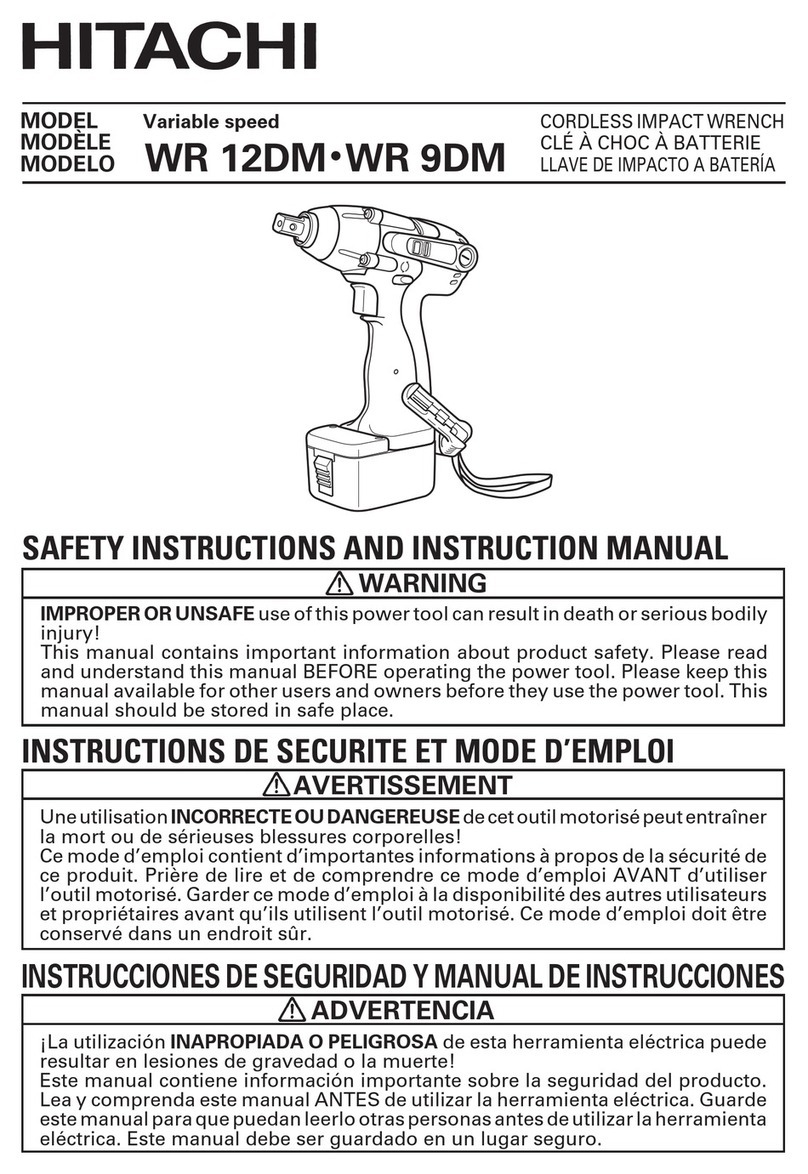
Hitachi
Hitachi WR 12DM Safety instructions and instruction manual
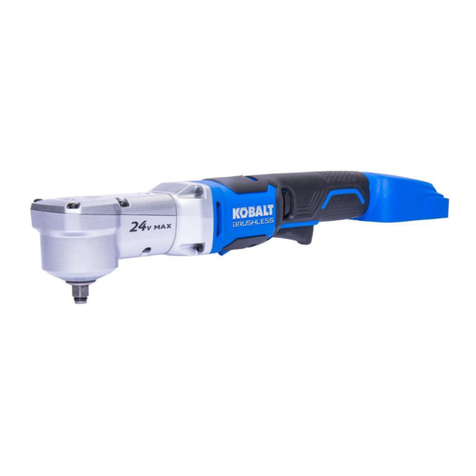
Kobalt
Kobalt KRAIW 124B-03 manual
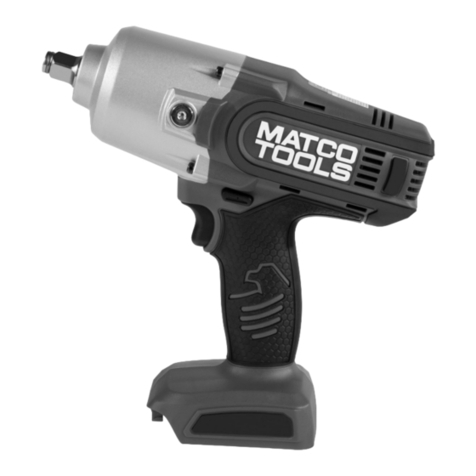
Matco Tools
Matco Tools MCL2012IW operating instructions
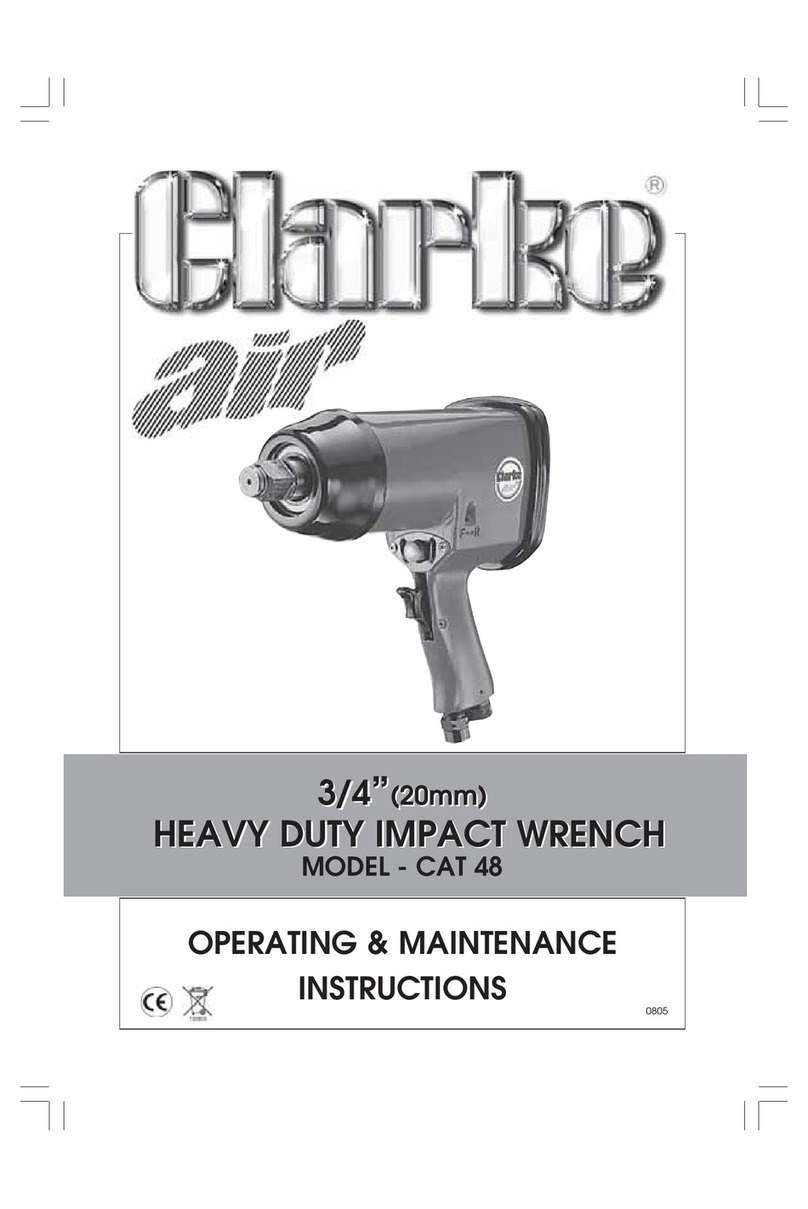
Clarke
Clarke CAT48 Operating & maintenance instructions

Cornwell Tools
Cornwell Tools CCT144IW operating instructions
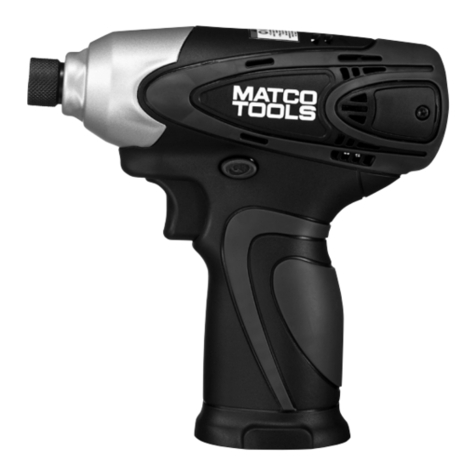
Matco Tools
Matco Tools MCL1214ID operating instructions
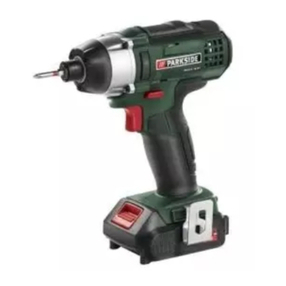
Parkside
Parkside PDSSA 18 A1 Translation of the original instructions

ATD Tools
ATD Tools ATD-10521 instruction manual

Makita
Makita TW0200 technical information
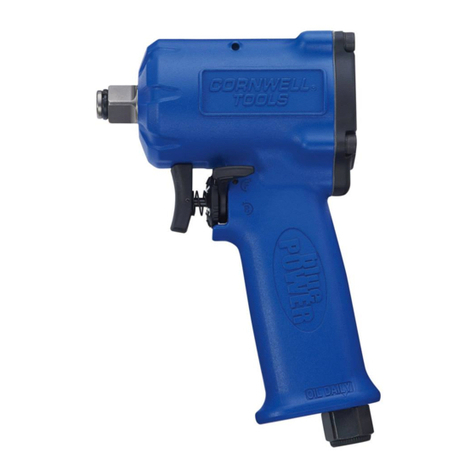
Cornwell Tools
Cornwell Tools CAT4112 operating instructions
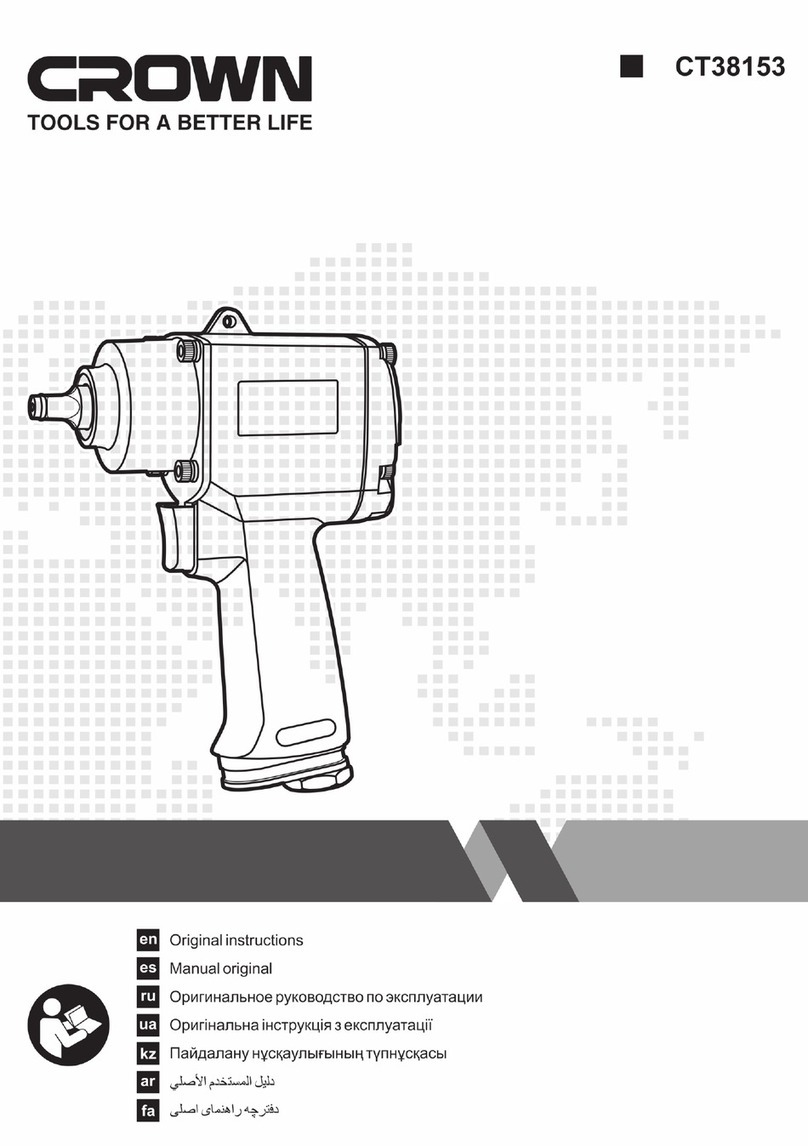
Crown
Crown CT38153 Original instructions


